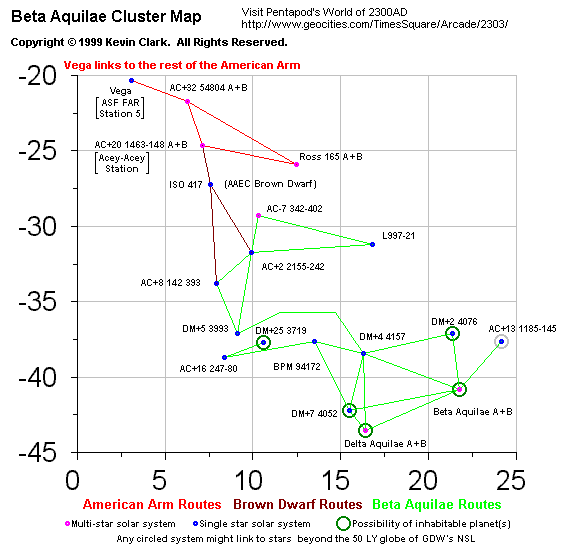
http://www.geocities.com/pentapod2300/best/betaqui.htm
To make full use of these maps and data, you will need access to the following issues of DGP's Travellers' Digest magazine, in which the details of the discovery and initial exploration of the Beta Aquilae Cluster are given.

ASF FAR Station 5 ( ASF FARS5): This is the fifth Forward Arming and Refueling ( FAR) Station established by the American Space Force. It was constructed on the surface of a large asteroid in the Vega system in 2224. In addition to its maintenance and logistical duties, it also provides biological containment facilities for exploration missions ( personnel quarantine for the returning crews, as well as "sealed" Biosecurity Level 4+ labs). While Acey-Acey Station was under construction, it acted as an interim base for the initial exploration of ISO 417 done by the HMAS Cook.
Acey-Acey Station ( AC+20 1463-148): This is a joint American-Australian station designed to support their exploration of the Beta Aquilae Cluster. It was constructed on the small asteroid named Horizon in the AC+20 1463-148 system in late 2300. When it is completed in early 2301, it will provide a maintenance, logistical, and biocontainment support base for the three ISV-5s which have been ordered to then start exploring the new cluster.
ISO 417 ( AAEC Brown Dwarf): This is the brown dwarf star which was discovered by the AAEC's (Australian-American Exploration Council) ISBIP ( Inter-System Baseline Interferometry Program) in early 2300. It opens up regular stutterwarp access to the Beta Aquilae Cluster. Before this, access to the cluster would have required the use of tugships ( the first working tugship was demonstrated by William Stanton in mid-2296).
Other than the brown dwarf, this system is essentially empty; no planets,
no comets, no asteroids, and no Oort cloud. This means that MHD and
open-cycle Fuel Cell powered starships must carry enough fuel to make it
past this system. Those with both closed-cycle Fuel Cells and Fuel
Processors could conceivably deploy solar panels and "crack" the water
back into LOX ( liquid oxygen) and LHyd ( liquid hydrogen), but given the
extremely weak "light" ( essentially all of it outside the visible spectrum)
this will require a much much larger solar panel array optimized for the
dwarf's spectrum ( and might still take months for just one load of fuel).